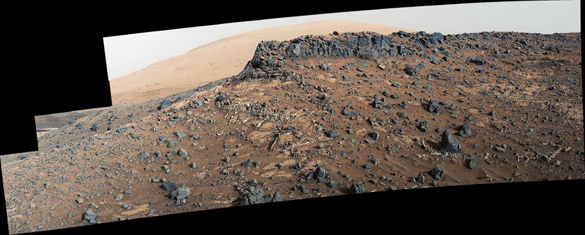 This view from the Mast Camera (Mastcam) on NASA’s Curiosity Mars rover shows a site with a network of prominent mineral veins below a cap rock ridge on lower Mount Sharp. The APXS instrument on Curiosity discovered unusual material in these veins that has the highest germanium concentrations found in Gale Crater. Courtesy/NASA
This view from the Mast Camera (Mastcam) on NASA’s Curiosity Mars rover shows a site with a network of prominent mineral veins below a cap rock ridge on lower Mount Sharp. The APXS instrument on Curiosity discovered unusual material in these veins that has the highest germanium concentrations found in Gale Crater. Courtesy/NASAAGU News:
New data gathered by the Mars Curiosity rover indicates a potential history of hydrothermal activity on the red planet, broadening the variety of habitable conditions once present there, scientists report in a new study.
Researchers found concentrations of the elements zinc and germanium to be 10 to 100 times greater in sedimentary rocks in Gale Crater compared to the typical Martian crust.
Zinc and germanium tend to cluster together in high temperature fluids and often occur together on Earth in hydrothermal deposits containing sulfur. The elevated concentrations of zinc and germanium in Gale Crater can potentially be explained by hydrothermal activity that occurred in the region, according to Jeff Berger, a geologist at the University of Guelph, in Ontario, Canada and lead author of the new study published in Journal of Geophysical Research: Planets, a journal of the American Geophysical Union.
Extreme thermal environments on Earth are home to a diverse array of microbial life adapted to these conditions, and these organisms may have been some of the first to evolve on Earth.
Now with potential evidence for hydrothermal conditions once present near Gale Crater, Curiosity’s mission takes another step toward determining if there were favorable environmental conditions for microbial life on Mars, according to the study’s authors.
“You have heat and you have chemicals … and basically food for life,” Berger said.
The new measurements come from the Alpha Particle X-Ray Spectrometer (APXS) on the Curiosity rover, which is exploring Mount Sharp in Gale Crater, the rover’s landing site.
Gale Crater formed 3.5 to 3.8 billion years ago from a meteor impact early in Mars’s history. Several hundred million years after the impact, the crater was filled in with 1 to 2 kilometers (0.6 to 1.25 miles) of sediment from its rim. Previous research has shown evidence that Gale Crater held a freshwater lake millions of years ago.
The rock record at Gale crater is fundamental for determining if Mars had environmental conditions favorable for microbial life, according to NASA. The new research illuminates what happened before and after the formation of the lake, according to Ashwin Vasavada, Curiosity mission project scientist at the NASA Jet Propulsion Laboratory in Pasadena, California, who was not a part of the new study.
In the new study, researchers used data from the Mars Science Laboratory APXS mounted on Curiosity’s robotic arm to measure 16 major, minor and trace elements in the rocks at Gale Crater, like zinc, in addition to the Chemistry and Mineralogy instrument in the rover’s body, which analyzes samples from its drill and scoop.
The study’s authors found zinc concentrations to be 10 to 100 times greater in rocks in Gale Crater than in the average composition of Martian crust. Germanium, however, is below the detection limit of the APXS instrument and scientists did not expect to see it. So when the data was analyzed for elements beyond the main 16 elements, the researchers were surprised to find germanium at concentrations 100 times higher than in the average Martian meteorite, Berger said. The new study is the first to include APXS measurements of germanium during the rover’s first 1,360 sols, or Martian days, which are 24 hours and 39 minutes long, according to the study’s authors.
Germanium tends to cluster near silicon in the rocks on Mars, in a predictable ratio of germanium to silicon. The new study found germanium in Martian rocks that was not in its typical cluster with silicon and did not show the standard germanium-silicon ratio.
The presence of zinc and germanium clustered together in such high concentrations points to the potential for hydrothermal activity, according to the study’s authors.
These elements cluster together in high temperature fluids and often occur together on Earth in hydrothermal deposits containing sulfur, according to the new study.
If Mars had water when Gale Crater was formed by a meteorite impact, the energy of the impact could have heated the planet’s crust and caused the fluids to circulate in a hydrothermal fashion, which could have concentrated zinc and germanium, according to Berger. The elements could also have been concentrated by volcanic activity that occurred before Gale Crater was formed. These enriched sediments were then carried by rivers to Gale Crater, he said.
The potential presence of hydrothermal systems during Mars’ ancient history adds to a “whole variety of conditions that might all fall under the umbrella of being habitable,” Vasavada said.

